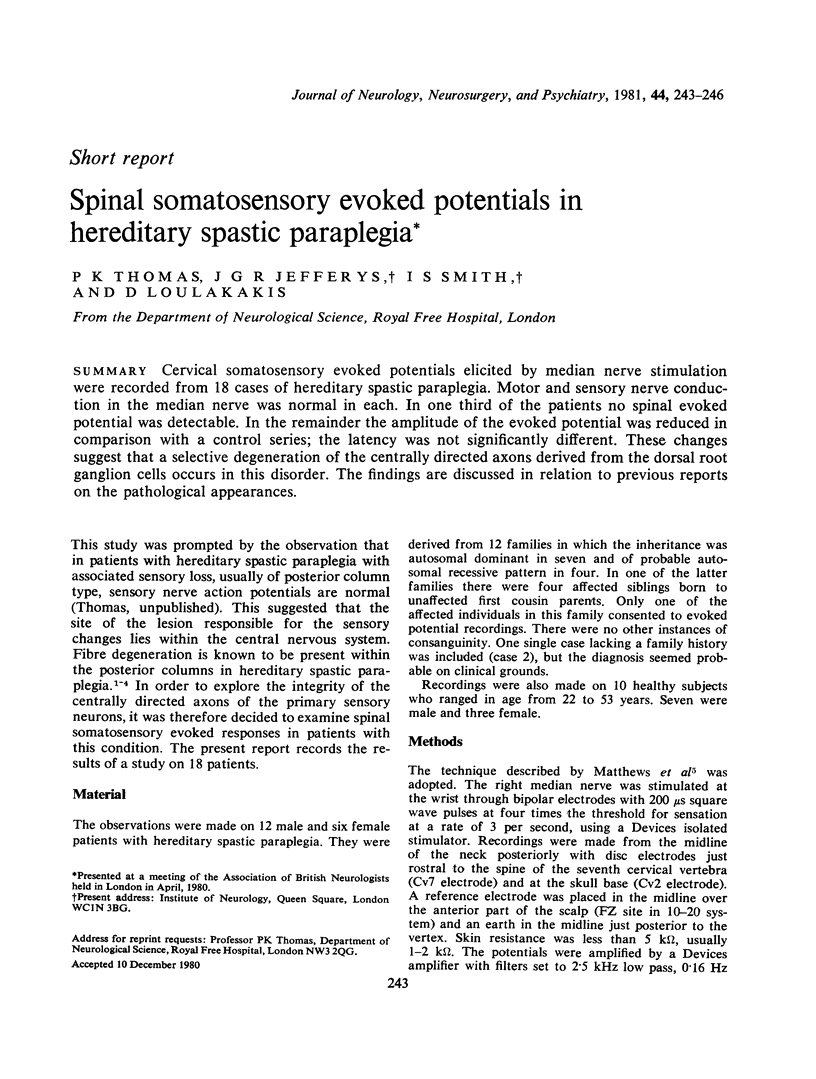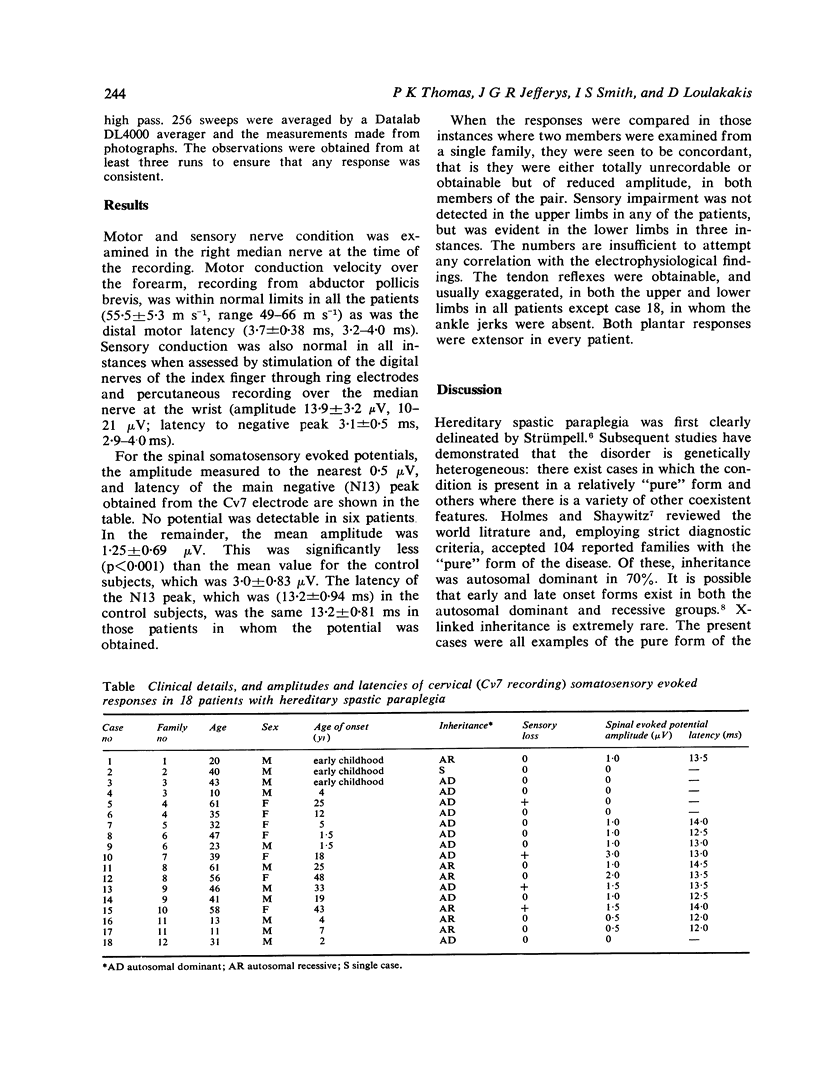Abstract
Cervical somatosensory evoked potentials elicited by median nerve stimulation were recorded from 18 cases of hereditary spastic paraplegia. Motor and sensory nerve conduction in the median nerve was normal in each. In one third of the patients no spinal evoked potential was detectable. In the remainder the amplitude of the evoked potential was reduced in comparison with a control series; the latency was not significantly different. These changes suggest that a selective degeneration of the centrally directed axons derived from the dorsal root ganglion cells occurs in this disorder. The findings are discussed in relation to previous reports on the pathological appearances.
Full text
PDF



Selected References
These references are in PubMed. This may not be the complete list of references from this article.
- Behan W. M., Maia M. Strümpell's familial spastic paraplegia: genetics and neuropathology. J Neurol Neurosurg Psychiatry. 1974 Jan;37(1):8–20. doi: 10.1136/jnnp.37.1.8. [DOI] [PMC free article] [PubMed] [Google Scholar]
- Cavanagh J. B., Gysbers M. F. "Dying back" above a nerve ligature produced by acrylamide. Acta Neuropathol. 1980;51(3):169–177. doi: 10.1007/BF00687383. [DOI] [PubMed] [Google Scholar]
- Cavanagh J. B. The significance of the "dying back" process in experimental and human neurological disease. Int Rev Exp Pathol. 1964;3:219–267. [PubMed] [Google Scholar]
- Holmes G. L., Shaywitz B. A. Strumpell's pure familial spastic paraplegia: case study and review of the literature. J Neurol Neurosurg Psychiatry. 1977 Oct;40(10):1003–1008. doi: 10.1136/jnnp.40.10.1003. [DOI] [PMC free article] [PubMed] [Google Scholar]
- Hughes J. T., Brownell B., Hewer R. L. The peripheral sensory pathway in friedreich's ataxia. An examination by light and electron microscopy of the posterior nerve roots, posterior root ganglia, and peripheral sensory nerves in cases of friedreich's ataxia. Brain. 1968;91(4):803–818. doi: 10.1093/brain/91.4.803. [DOI] [PubMed] [Google Scholar]
- Jones S. J., Baraitser M., Halliday A. M. Peripheral and central somatosensory nerve conduction defects in Friedreich's ataxia. J Neurol Neurosurg Psychiatry. 1980 Jun;43(6):495–503. doi: 10.1136/jnnp.43.6.495. [DOI] [PMC free article] [PubMed] [Google Scholar]
- Krinke G., Schaumburg H. H., Spencer P. S., Thomann P., Hess R. Clioquinol and 2,5-hexanedione induce different types of distal axonopathy in the dog. Acta Neuropathol. 1979 Aug;47(3):213–221. doi: 10.1007/BF00690549. [DOI] [PubMed] [Google Scholar]
- Matthews W. B., Beauchamp M., Small D. G. Cervical somato-sensory evoked responses in man. Nature. 1974 Nov 15;252(5480):230–232. doi: 10.1038/252230a0. [DOI] [PubMed] [Google Scholar]
- McLeod J. G. An electrophysiological and pathological study of peripheral nerves in Friedreich's ataxia. J Neurol Sci. 1971 Mar;12(3):333–349. doi: 10.1016/0022-510x(71)90067-0. [DOI] [PubMed] [Google Scholar]
- McLeod J. G., Morgan J. A., Reye C. Electrophysiological studies in familial spastic paraplegia. J Neurol Neurosurg Psychiatry. 1977 Jun;40(6):611–615. doi: 10.1136/jnnp.40.6.611. [DOI] [PMC free article] [PubMed] [Google Scholar]
- SCHWARZ G. A. Hereditary (familial) spastic paraplegia. AMA Arch Neurol Psychiatry. 1952 Nov;68(5):655–662. doi: 10.1001/archneurpsyc.1952.02320230081010. [DOI] [PubMed] [Google Scholar]
- SCHWARZ G. A., LIU C. N. Hereditary (familial) spastic paraplegia; further clinical and pathologic observations. AMA Arch Neurol Psychiatry. 1956 Feb;75(2):144–162. doi: 10.1001/archneurpsyc.1956.02330200038005. [DOI] [PubMed] [Google Scholar]
- Spencer P. S., Sabri M. I., Schaumburg H. H., Moore C. L. Does a defect of energy metabolism in the nerve fiber underlie axonal degeneration in polyneuropathies? Ann Neurol. 1979 Jun;5(6):501–507. doi: 10.1002/ana.410050602. [DOI] [PubMed] [Google Scholar]
- Spencer P. S., Schaumburg H. H. Ultrastructural studies of the dying-back process. III. The evolution of experimental peripheral giant axonal degeneration. J Neuropathol Exp Neurol. 1977 Mar-Apr;36(2):276–299. doi: 10.1097/00005072-197703000-00005. [DOI] [PubMed] [Google Scholar]


